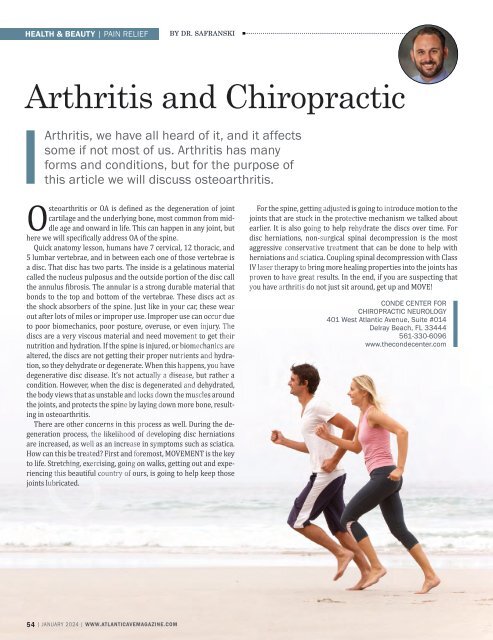AA_Jan24_WEB
You also want an ePaper? Increase the reach of your titles
YUMPU automatically turns print PDFs into web optimized ePapers that Google loves.
HEALTH & BEAUTY | PAIN RELIEF<br />
BY DR. SAFRANSKI<br />
Arthritis and Chiropractic<br />
Arthritis, we have all heard of it, and it affects<br />
some if not most of us. Arthritis has many<br />
forms and conditions, but for the purpose of<br />
this article we will discuss osteoarthritis.<br />
Osteoarthritis or OA is defined as the degeneration of joint<br />
cartilage and the underlying bone, most common from middle<br />
age and onward in life. This can happen in any joint, but<br />
here we will specifically address OA of the spine.<br />
Quick anatomy lesson, humans have 7 cervical, 12 thoracic, and<br />
5 lumbar vertebrae, and in between each one of those vertebrae is<br />
a disc. That disc has two parts. The inside is a gelatinous material<br />
called the nucleus pulposus and the outside portion of the disc call<br />
the annulus fibrosis. The annular is a strong durable material that<br />
bonds to the top and bottom of the vertebrae. These discs act as<br />
the shock absorbers of the spine. Just like in your car, these wear<br />
out after lots of miles or improper use. Improper use can occur due<br />
to poor biomechanics, poor posture, overuse, or even injury. The<br />
discs are a very viscous material and need movement to get their<br />
nutrition and hydration. If the spine is injured, or biomechanics are<br />
altered, the discs are not getting their proper nutrients and hydration,<br />
so they dehydrate or degenerate. When this happens, you have<br />
degenerative disc disease. It’s not actually a disease, but rather a<br />
condition. However, when the disc is degenerated and dehydrated,<br />
the body views that as unstable and locks down the muscles around<br />
the joints, and protects the spine by laying down more bone, resulting<br />
in osteoarthritis.<br />
There are other concerns in this process as well. During the degeneration<br />
process, the likelihood of developing disc herniations<br />
are increased, as well as an increase in symptoms such as sciatica.<br />
How can this be treated? First and foremost, MOVEMENT is the key<br />
to life. Stretching, exercising, going on walks, getting out and experiencing<br />
this beautiful country of ours, is going to help keep those<br />
joints lubricated.<br />
For the spine, getting adjusted is going to introduce motion to the<br />
joints that are stuck in the protective mechanism we talked about<br />
earlier. It is also going to help rehydrate the discs over time. For<br />
disc herniations, non-surgical spinal decompression is the most<br />
aggressive conservative treatment that can be done to help with<br />
herniations and sciatica. Coupling spinal decompression with Class<br />
IV laser therapy to bring more healing properties into the joints has<br />
proven to have great results. In the end, if you are suspecting that<br />
you have arthritis do not just sit around, get up and MOVE!<br />
CONDE CENTER FOR<br />
CHIROPRACTIC NEUROLOGY<br />
401 West Atlantic Avenue, Suite #014<br />
Delray Beach, FL 33444<br />
561-330-6096<br />
www.thecondecenter.com<br />
COPYRIGHTED<br />
54 | JANUARY 2024 | WWW.ATLANTICAVEMAGAZINE.COM

















